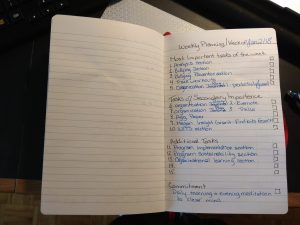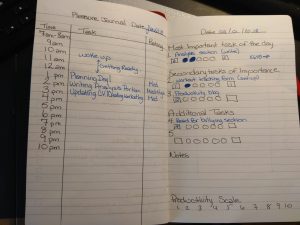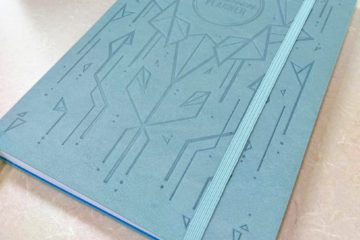Update on how I use planners can be found here
Lately, I have been trying my best to organize my academic (and personal?) life. I’ve been struggling to stay focused and productive with my research and writing. So I have implemented a few tools to try and organize and track my tasks. I will start a series of blog posts covering the various tools I have been using and how they are working for me so far.
Tools I have implemented:
Today, I will share with you my experience with the daily productivity journal.
Inspiration
I had been browsing various 5-minute journals online to help me focus on the positive things that occur in my life day to day. As we know, this is something that can often be overlooked and hard to do when in grad school. In my search, I came across a productivity journal.
I had previously found the Pomodoro technique to be quite useful in keeping me on task. Despite loving data and concrete evidence of effectiveness, I had never really thought of tracking time spent on specific tasks, or planning with Pomodoro time allotments in mind. Let’s be honest, I rarely planned my day, let alone my week.
The Journal
So the notion of sitting down and actually thinking about what is important each week seemed like a good place to start. Then to follow through with assigning priority to tasks for each day. However, we must remember that I am not a planner, so my tasks were often quite vague (e.g., “work on proposal” or “work on literature review section of proposal”). My friend/colleague, Karen, pointed out to me that this was far too high level. So I worked with my partner, a program manager, to learn how to break down the tasks (more on this when we explore Trello).
 For my purposes, I felt that a hard copy (rather than digital) evoked intention and reflection. However, I did not want to invest $20 some dollars if I wasn’t going to stick with it (as is often the case when I start something to keep myself organized). So, I bought a cheap hardcover journal. Every week I write out the template (yes this is tedious, but again, I feel that it allows me time to reflect on what I am doing and why I want to do this). I then use a different coloured pen to fill in the tasks. Assign expected number of Pomodoro sessions. At the end of every day, or first thing in the morning the following day, I will complete the productivity score (1–10). Up until recently, I have been completing this quite subjectively. But lately, I have come to the realization that 10 Pomodoro sessions is a good goal for the day, so I will base my productivity on the number of Pomodoro sessions I have.
For my purposes, I felt that a hard copy (rather than digital) evoked intention and reflection. However, I did not want to invest $20 some dollars if I wasn’t going to stick with it (as is often the case when I start something to keep myself organized). So, I bought a cheap hardcover journal. Every week I write out the template (yes this is tedious, but again, I feel that it allows me time to reflect on what I am doing and why I want to do this). I then use a different coloured pen to fill in the tasks. Assign expected number of Pomodoro sessions. At the end of every day, or first thing in the morning the following day, I will complete the productivity score (1–10). Up until recently, I have been completing this quite subjectively. But lately, I have come to the realization that 10 Pomodoro sessions is a good goal for the day, so I will base my productivity on the number of Pomodoro sessions I have.

You’ll notice I still keep the weekly goals/tasks quite high level. It doesn’t make sense to me to break these down to much, as I would probably have more than 15 tasks if I did. So during the daily planning, I attempt to break them down much more.
We will see how this works out, as I can already see issues regarding the number of tasks I actually complete within the expected Pomodoro sessions. For example, I may anticipate things to take longer than they actually do. So if I only complete 7 Pomodoros but I complete all my expected tasks for the day, is that day a 7 or a 10 (because I completed everything I set out to do)?
At the end of the week you then reflect about what went well, what was learned, and what didn’t get done. You then can set a goal of how you plan to keep on track, or be more productive in the upcoming week. For example, after a couple of semi-productive weeks where I missed some days in completing the journal, I set a relevant goal for myself. I would take 15 minutes every morning to plan out my day. This would then prime my brain to what needs to be accomplished and get me into the right mindset to tackle the day.
Other things that were recommended to me

To the left is the pleasure rating of tasks while the righthand page has a breakdown of today’s tasks. I jot down how many words key writing tasks are at when I start, then at the end of the day jot down the word count to see the progress (I’m not sure this is useful yet).
After meeting with my counsellor, we have discussed my motivation (or lack thereof). She suggested a different focus on my “journaling” journey. She did recommend a gratitude journal, along with the pleasure journal (I have not been able to find an example online). For every hour of the day, record what I did, and the pleasure rating I would give it. After each day, go through and code for tasks that relate to my goals (school, life, work). Once activities are colour coded, look for tasks that are higher in pleasure and perhaps fulfil multiple goals, and maximize those. I have just started this, so we will see how it goes.
Also, I do find the prioritizing task of the productivity journal to be helpful and makes me set my goals and intentions for the day each morning. So I don’t think I will move away from that just yet.



0 Comments